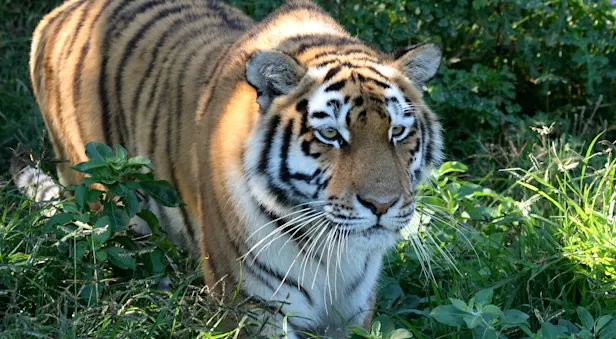Conservation | Sri Lankan Elephants
The Sri Lankan subspecies is the largest and also the darkest of the Asian elephants, with patches of depigmentation—areas with no skin color—on its ears, face, trunk and belly. Once found throughout the tear-shaped island at the bottom of India’s southern tip, these elephants are now being pushed into smaller areas as development activities clear forests and disrupt their ancient migratory routes.
The herd size in Sri Lanka ranges from 12-20 individuals or more. It is led by the oldest female, or matriarch. In Sri Lanka, herds have been reported to contain nursing units, consisting of lactating females and their young, and juvenile care units, containing females with juveniles. The Sri Lankan elephant population has fallen almost 65% since the turn of the 19th century. Today, the Sri Lanka elephant is protected under the Sri Lankan law and killing one carries the death penalty.
Elephants hold symbolic, cultural and economic importance in Sri Lanka. They attract tourists who visit national parks to observe elephants in the wild. They support logging operations by dragging felled logs and have special significance in religious events.
THREATS
CONFLICT WITH HUMANS
As a result of forest clearing, human-elephant conflicts have also increased and led to the destruction of property and death of both humans and elephants. The problem is compounded by the elephant's preference for crops such as sugar cane, bananas and other fruits frequently grown in the region. In 1997, about 126 wild elephants were lost as a result of human-elephant conflict—a rate of about 2.4 elephants per week. Current recorded levels of mortality would indicate that about 6% of the animals in the wild are dying annually.
HABITAT LOSS
The primary threat to Sri Lankan elephants is the loss of forests. The large blocks of forests they require are increasingly fragmented by clearing for human settlements and expanding agriculture in Sri Lanka.
WHAT WWF IS DOING
WWF's elephant work in South Asia focuses on creating a future for elephants in a landscape dominated by humans. WWF invests in helping communities manage human-elephant conflict, reducing impacts on elephant populations, preventing further habitat loss and—most importantly— lowering local animosity against elephants.
REDUCING HUMAN-ELEPHANT CONFLICT
WWF supports human-elephant conflict management activities, biodiversity conservation, and awareness-building among local communities in a number of landscapes across Asia, including in Assam, India, Myanmar, and Vietnam, among others.
In Assam, WWF supports implementation of low-cost electric fencing, as well as support for other tools and techniques to help communities protect their crops and settlements from elephant incursions; supports the development of community response teams to safely drive elephants away from human inhabited areas; disseminates awareness information to communities on the dos and don'ts of living with elephants; and engages in policy and advocacy efforts to address land-use and other drivers of human-elephant conflict.
In Myanmar, WWF supports protection efforts to counter the killing of elephants for their skin, which is marketed for various purposes. In addition, WWF is working to address human-elephant impacts on the ground in Myanmar that are also closely linked to poaching. These efforts help build support for elephant conservation among struggling communities in the long term.
PROTECTING ELEPHANT HABITAT
In the Terai Arc Landscape, which encompasses parts of western Nepal and eastern India, WWF and its partners restore degraded biological corridors so that elephants can access their migratory routes without disturbing places where people live. The long-term goal is to reconnect 12 protected areas and encourage community-based action to reduce and manage human-elephant conflict. Such approaches are being facilitated by WWF across the range of the Asian elephant.
SECURING HEALTHY FORESTS
In Sumatra, which is one of the world's deforestation hotspots, business-as-usual conservation won't cut it. So WWF and partners are pursuing a cutting-edge strategy to protect one of the last elephant strongholds in central Sumatra. In the Bukit Tigapuluh, or Thirty Hills, landscape, WWF-Indonesia is actively managing a nearly 100,000-acre ecosystem restoration concession with two other conservation partners.
The goal: to conserve and restore the forest to maintain important carbon stocks, conserve biodiversity, and support the environment of forest-dependent Indigenous communities. There are an estimated 150 critically endangered Sumatran elephants living in Thirty Hills, making it one of the last viable populations in the rapidly deforested central part of the island.
HALTING POACHING AND STOPPING TRADE
In response to high incidents of elephant and tiger poaching in a number of range countries, WWF and its local partners have coordinated wildlife patrol units that conduct antipoaching patrols, confiscate snares and other means of trapping animals, educate local people on the laws in place concerning poaching, and help authorities apprehend criminals. The evidence collected by wildlife patrol units has helped bring known poachers to court. In many Asian countries, WWF works with TRAFFIC, the wildlife trade monitoring network, to reduce the threat that illegal and illicit domestic ivory markets pose to wild elephants.



































